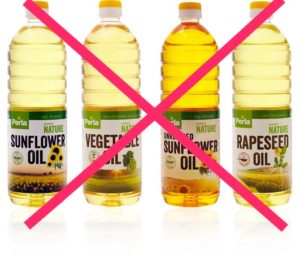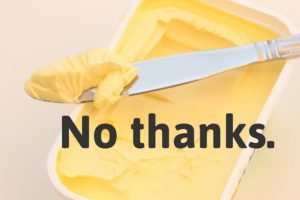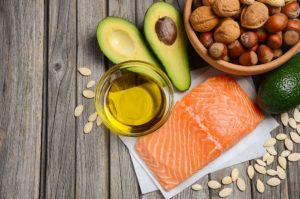Hey there! So we made it through Objective 1, and are on to our next goal! Keep in mind that we’re making small changes that add up to HUGE results in your overall health. That means you have to keep up all the good work you did on the past objectives, and add in each new goal. So keep on drinking all that water while you work on this next step!
Objective #2: Ditch Damaged Fats
Timeframe: 3 Weeks
Understanding fats – what they are, the roles they play in our bodies, and good vs. bad fats – is vital to having good health. There are a lot of myths and misconceptions out there about fats, and they have been vilified for a long time. The good news is, I’m going to help you sort all of this out, and get you on track with eating the right kinds, and the right amounts of fats.
Here are some common myths you may have heard (or even believe) about fats:
- A low-fat diet is good for you, and heart healthy.
- Eating cholesterol-rich foods gives you high cholesterol.
- Processed seed and vegetable oils are good, and good for you.
- Eating fat makes you fat.
- Processed low-fat foods are better for you, and will help you lose weight.
Now, let’s talk about the facts. I’ll just go number by number here.
- Back in the 60s and 70s, there were some major political moves by big business and big agriculture to fund some studies regarding fats and cholesterol. Now, these studies really weren’t able to prove any correlation between eating saturated fats and cholesterol, and they weren’t thorough or well-conducted, but money is power, and the results were skewed to fit what these big companies wanted. These studies became the cornerstone of the low-fat diet. Food companies rushed to produce low-fat products, drug companies were able to push their so-called cholesterol-lowering drugs, and Americans followed the recommendations set forth by the government. The bottom line is that since that time, many complete and thorough studies have been conducted, and there is no evidence that low-fat diets help you lose weight or reduce the risk of chronic diseases. In fact, there is evidence that low-fat diets can actually cause you harm. Some additional resources: Women’s Health Initiative, Study regarding low-fat, high-carb diets and triglycerides, study regarding low-fat diets actually lowering good (HDL) cholesterol levels, Why We Get Fat and What To Do About It by Gary Taubes.
- Cholesterol containing foods actually make very little difference in our serum (blood) cholesterol levels. Our bodies naturally produce cholesterol – it’s essential to our bodies, and a critical component of our cells. High cholesterol is a sign of metabolic imbalance, and other factors need to be considered when looking at cholesterol numbers. I highly recommend reading The Great Cholesterol Myth for more information on this subject.
- Vegetable and seed oils, including canola, corn, soybean and sunflower oil, are highly processed, damaged oils. They are oxidized, which, in the simplest of terms, means they are rancid. This oxidation is caused by heat, air and light. This oxidation is what causes damage to our blood vessels and arteries, which is what leads to plaque build up. It also damages our tissues, cells, and even our DNA, and causes aging in our bodies. Processed oils have to be bleached and deodorized before they hit the store shelves just to make them palatable for us to consume them! That’s really gross, if you ask me. Oh, and this applies to margarine, too. Margarine is chock-full of damaged and hydrogenated oils.

- Our bodies need fat. Fat is a concentrated source of energy for our bodies. Fat is necessary for the absorption and transport of fat-soluble vitamins A, E, D and K. It’s an essential part of all cell membranes, is needed for the protection of our nerves and spinal cord, it protects our organs and is an important precursor for hormones. Our brain is 60% fat, and it’s essential that our bodies get fat through our diet. When you choose healthy sources of fat, your body is able to use it, and it doesn’t make you get fat. Sugar, processed carbohydrates of all kinds, and an excess of carbohydrates in general, is what actually makes us fat.
- Processed low-fat foods are among the worst foods you can choose to eat. Most of them contain trans fats (more on this below), which are super damaging to your body. And guess what? When they remove fat from something, they are also taking away flavor, and the carrier for flavor. That means they have to add in sugar, processed oils/damaged fats, and who knows what else just to make that food taste good. Processed foods are almost always going to contribute to weight gain.
Trans Fats
I’m giving trans fats their own section because they are particularly harmful. Trans fats are created through hydrogenation. This is the process of adding hydrogen molecules to vegetable oil molecules in order to harden them, and make them artificially saturated. Trans fats are TOXIC to the human body. Some of the highlights of trans fat damage:
- Low birth weight in infants
- Lowers breast milk volume
- Lowers breast milk quality
- Reduced visual acuity in infants
- Greater risk of childhood asthma
- Abnormal sperm production, decreased testosterone production and increased risk of prostate disease
- Increased rate of heart disease
- Lowers HDL (good) cholesterol; raises LDL (bad) cholesterol
- Increased rate of cancer
- Increased rate of diabetes
- Increased obesity
- Damage to blood vessels, arteries, tissues, organs, cells and DNA
- Increased rate of aging
There is absolutely no safe level of trans fat consumption. They cause damage at all intake levels. Trans fats are found in processed foods including (but not limited to) baked goods, margarine, Crisco, frozen pizza, crackers, cookies, frozen waffles and more. Basically, you can find them in just about any packaged, processed foods. Here’s the real kicker: there’s a loophole in the labeling laws, so if a product contains less than 0.5g of trans fat per serving, the manufacturer can label the product trans fat free or list “Trans fat 0g” on the nutrition label. Oh, and to top it all off, the manufacturer sets the serving size, so they can make it whatever they want in order to be able to label it free of trans fat. So, YOU MUST READ THE INGREDIENTS on anything you buy. Yes, I shouted at you a little bit because this is really important. Check the ingredient list for hydrogenated or partially-hydrogenated anything. Those are trans fats and you don’t want to eat them or give them to your kids. Or your dog, for that matter.
Your Objective: For the next 3 weeks, work on eliminating those damaged fats from your diet. Yes, this means I’m asking you to toss out your vegetable oil, margarine, low-fat foods and anything that has trans fats (read the ingredients!).
Oils to Avoid: margarine (this includes any “buttery spread” like Earth Balance, Benecol and I Can’t Believe It’s Not Butter), hydrogenated or partially hydrogenated oils of any type, canola (rapeseed) oil, corn oil, rice bran oil, safflower oil, soybean oil, sunflower oil or vegetable oil.
Now that you know why you need to ditch the damaged fats, and you’re starting to clear your kitchen of them, let’s talk about which healthy fats to start adding into your diet.
Ideal For Cooking (organic and unrefined are best when possible)
- Coconut oil
- Butter/ghee
- Avocado oil
- Lard
- Tallow
- Duck fat
- Extra Virgin Olive oil
- Nut oils (walnut, pecan, macadamia) – best for cold use
- Flaxseed oil – best for cold use. Higher in polyunsaturated fatty acids, so consume in extremely limited amounts.
- Palm oil (from sustainable sources is best)
- Grapeseed oil (note: there is some disagreement as to the stability of this oil. Best for cold use.)
Plant Sources
- Avocado
- Olives
- Nuts (walnuts, almonds, hazelnuts, pecans, cashews)
- Seeds (flax, chia, hemp, sesame, sunflower, pumpkin)
- Nut and seed butters (especially almond, sesame and sunflower)
Animal Sources (organic and pastured is best when possible)
- Cold water fish (salmon, halibut, mackerel, cod, herring)
- Chicken
- Eggs
- Dairy (always choose full-fat dairy – whole milk, heavy cream, half and half)
- Butter/ghee
- Grass-fed beef or lamb
A serving of nuts and seeds is 2 Tablespoons, and a serving of the healthy oils listed above is 1 Tablespoon. You should get at least 2-3 servings per day. A serving of animal protein (fish, grass-fed beef, eggs or milk, in this case) is 3-4 ounces, and you should get 2-4 servings per day. Ideally, you would eat fish every day, but 2-3 times per week is a great place to start.
Keep in mind that fat helps you to feel full, and it’s good for you, so don’t be afraid to add it into your diet. Nuts and seeds are a great snack, and you can easily drizzle butter over your veggies or olive oil over your salad to help you get in those healthy fats. Half of a small avocado is easy to add as a breakfast side or to a salad. Sprinkle seeds or nuts over salads or veggies to add a little crunch and some healthy fats. Roasted salmon with a drizzle of herbed butter, and a squeeze of lemon is a quick and easy meal packed with healthy fats. Put a dollop of whipped cream on top of berries for a delicious, and healthy, dessert!
Let’s be real: Ditching those damaged fats is easier to put in place at home. Cooking at eating at home is absolutely the best way to eat healthy and know exactly what’s in your food. When you dine out, especially if you’re eating fast food, you’re being exposed to all kinds of damaged and hydrogenated fats. When dining out, be sure to choose the highest quality restaurants possible, and keep meals out to a minimum. It’s also okay to ask what kind of oils they use, and ask them to leave those out of your dish. Of course, that won’t work at a fast food restaurant, but most sit down restaurants are happy to comply with dietary restrictions.
This is a lot of information to absorb, but I hope you walk away knowing not to be afraid of eating fat, and that it’s the damaged fats that wreak havoc in our bodies. I’m here if you have questions! Don’t forget that it’s not too late to join the email list for extra info and resources. I also have a Facebook group for subscribers only. So sign up for my emails to get details on how to join the group! I’ll be offering a lot of additional info and videos for this objective, and you won’t want to miss it!
 Note that there’s a lot of additional info about fats and essential fatty acids to know and understand, but that’s way too much to go into here. Some of it I will be discussing in our Facebook group. If you have specific concerns regarding your health, your current diet or your cholesterol levels, working with a Certified Nutrition Consultant can be helpful in determining the best nutritional protocol for your specific needs. Send me an email if you’re interested in working together!
Note that there’s a lot of additional info about fats and essential fatty acids to know and understand, but that’s way too much to go into here. Some of it I will be discussing in our Facebook group. If you have specific concerns regarding your health, your current diet or your cholesterol levels, working with a Certified Nutrition Consultant can be helpful in determining the best nutritional protocol for your specific needs. Send me an email if you’re interested in working together!
Choosing unrefined and organic (when possible) plant and animal fats is key to having better health. Good fats do so much in our body: they are important for the proper functioning of our body, and are vital for the absorption of certain vitamins and minerals. Fat doesn’t make you fat, but damaged fats can (and will) kill you.
Follow me on Facebook, Instagram and Twitter over the next two weeks for additional info to help keep you on track and working towards your goal!
Tell me: Which damaged fats are you ditching and which healthy fats are you adding to your diet?




0 Comment